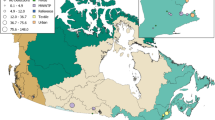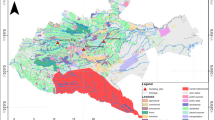Abstract
Bisphenol A (BPA) is a manmade chemical that is only found in the environment due to anthropogenic activities. A total of 1150 surface freshwater samples were collected and analysed for BPA at 44 sampling sites in Canada from 2012 to 2018. The resultant concentrations ranged from 3.05 to 1888.51 ng/L. In addition, 64% of the samples were reported to be under the detection limit of the laboratory. In comparison, the Federal Environmental Quality Guideline for the protection of aquatic life is 3500 ng/L. Sampling sites were categorised into four groups based on the dominant activities present upstream in their watersheds: reference sites, mixed use sites, urban sites, and municipal waste water treatment plants (MWWTP) associated sites. Based on the results of this study, detections of BPA in water samples were more frequent in urban and MWWTP-associated sites. Additionally, there does not seem to be a statistically significant temporal (upward or downward) or spatial trend in BPA concentrations in Canadian surface waters from 2012 to 2018 only. Overall, Canadian BPA results are of similar concentrations to that of other countries in Asia and Europe.




Similar content being viewed by others
References
AIST (Japan’s National Institute of Advanced Industrial Science and Technology) (2007) AIST risk assessment document series 4. Bisphenol A
AXYS (2013) MLA method 082. Bisphenol A in Biosolid, Solid, Influent, Effluent and other Environmental Aqueous Samples, Rev 01. Sidney, BC, Canada
Azevedo DdA, Lacorte S, Viana P, Barceló D (2001) Occurrence of nonylphenol and bisphenol-A in surface waters from Portugal. J Braz Chem Soc 12:532–537
Boyd GR, Reemtsma H, Grimm DA, Mitra S (2003) Pharmaceuticals and personal care products (PPCPs) in surface and treated waters of Louisiana, USA and Ontario, Canada. Sci Total Environ 311(1–3):135–149
Canada (2018) Bisphenol A factsheet. https://www.canada.ca/en/health-canada/services/chemical-substances/fact-sheets/chemicals-glance/bisphenol-a.html
Canadian Environmental Protection Act (CEPA) (1999) https://www.canada.ca/en/environment-climate-change/services/canadian-environmental-protection-act-registry/publications/canadian-environmental-protection-act-1999.html
Chen M, Ohman K, Metcalfe C, Ikonomou MG, Amatya P, Wildon J (2006) Pharmaceuticals and endocrine disruptors in wastewater treatment effluents and in the water supply system of Calgary, Alberta, Canada. Water Qual Res J Can 41(4):351–364
Corrales J, Kristofco LA, Steele WB, Yates BS, Breed CS, Williams ES, Brooks BW (2015) Global assessment of BPA in the environment: review and analysis of its occurence and bioaccumulation. Dose response 13(3):1–29
Elliott SM, Brigham ME, Kiesling RL, Schoenfuss HL, Jorgenson ZG (2018) Environmentally relevant chemical mixtures of concern in waters of United States tributaries to the Great Lakes. Integr Environ Asses Manag 14:509–518
Environment Canada and Health Canada (2008) Screening assessment for the challenge phenol, 4,4′-(1-methylethylidene)bis-(Bisphenol A). Chemical Abstracts Service Registry Number 80-05-7. http://www.ec.gc.ca/ese-ees/default.asp?lang=En&n=3C756383-1#a7. Accessed March 2019
Environmental Protection Agency (EPA) (1992) OSWER Directive 9240.0-05A specifications and guidance for contaminant-free sample containers. National Technical Information Service. EPA/ROD/R04-92/114
EU (2008) European Union updated risk assessment report. Bisphenol A, CAS No: 80-05-7. Institute for Health and Consumer Protection, European Chemicals Bureau, European Commission Joint Research Centre, 3rd Priority List, Luxembourg: Office for Official Publications of the European Communities
Funakoshi G, Kasuya S (2009) Influence of an estuary dam on the dynamics of bisphenol A and alkylphenols. Chemosphere 75:491–497
Helsel D (2005) Nondetects and data analysis: statistics for censored environmental data. Wiley, Hoboken
Helsel D (2006) Fabricating data: how substituting values for nondetects can ruin results, and what can be done about it. Chemosphere 6511:2434–2439
Helsel D (2012) Statistics for censored environmental data using Minitab and R, 2nd edn. Wiley, Hoboken
Helsel D, Lee L (2006) Analysis of environmental data with nondetects. In: Statistical methods for censored environmental data. ASA Workshop, Seattle, Washington. https://www.practicalstats.com/nada/downloads.html
Kleywegt S, Pileggi V, Yang P, Hao C, Rocks C, Thach S, Cheung P, Whitehead B (2011) Pharmaceuticals, hormones and bisphenol A in untreated source and finished drinking water in Ontario, Canada—occurrence and treatment efficiency. Sci Total Environ 409(8):1481–1488
Lee HB, Peart TE (2000) Bisphenol A contamination in Canadian municipal and industrial wastewater and sludge samples. Water Qual Res 35(2):283–298
Lee HB, Peart TE, Gris G, Chan C (2002) Endocrine-disrupting chemicals in industrial wastewater samples in Toronto, Ontario. Water Qual Res J Canada 37(2):459–472
Lee HB, Peart TE, Chan J, Gris G (2004) Occurrence of endocrine-disrupting chemicals in sewage and sludge samples in Toronto, Canada. Water Qual Res J Canada 39(1):57–63
Lee CC, Jiang LY, Kuo YL, Hsieh CY, Chen CS, Tien CJ (2013) The potential role of water quality parameters on occurrence of nonylphenol and bisphenol A and identification of their discharge sources in the river ecosystems. Chemosphere 91:904–911
Mizukawa A, Reichert G, Filippe TC, Brehm FA, Rodrigues de Azevedo JC (2018) Occurrence and risk assessment of personal care products in subtropical urban rivers. Environ Eng Sci 35(11):1263–1272
Quednow K, Püttmann W (2008) Endocrine disruptors in freshwater streams of Hesse, Germany: changes in concentration levels in the time span from 2003 to 2005. Environ Poll 152:476–483
Sosiak A, Hebben T (2005) A preliminary survey of pharmaceuticals and endocrine-disrupting compounds in treated municipal wastewaters and receiving rivers of Alberta. https://open.alberta.ca/publications/0778539374. Accessed March 2019
Staples CA, Woodburn KB, Klecka GM, Mihaich EM, Hall AT, Ortego L, Caspers N, Hentges SG (2008) Comparison of four species sensitivity distribution methods to calculate predicted no effect concentrations for bisphenol A. Hum Ecol Risk Assess 14(3):455–478
R Core Team (2013) R: a language and environment for statistical computing. In: R Foundation for statistical computing. Vienna, Austria. http://www.R-project.org/
Waiser MJ, Humphrie D, Tumber V, Holm J (2011) Effluent-dominated streams. Part 2: presence and possible effects of pharmaceuticals and personal care products in Wascana Creek, Saskatchewan, Canada. Environ Toxicol Chem 30(2):508–519
Yamazaki E, Yamashita N, Taniyasu S, Lam J, Lam PKS, Moon HB, Jeong Y, Kannan P, Achyuthan H, Munuswamy N, Kannan K (2015) Bisphenol A and other bisphenol analogues including BPS and BPF in surface water samples from Japan, China, Korea and India. Ecotoxicol Environ Saf 122:565–572
Yu F, Pan X, Wang B (2012) Determination of four phenolic endocrine disrupting chemicals in Dianchi Lake, China. Int J Environ Anal Chem 92:1532–1545
Zhang Z, Ren N, Kannan K, Nan J, Liu L, Ma W, Qi H, Li Y (2014) Occurrence of endocrine-disrupting phenols and estrogens in water and sediment of the Songhua River, Northeastern China. Arch Environ Con Toxicol 66:361–369
Acknowledgments
Funding provided by the Chemicals Management Plan. Monique de Jong for creating R scripts, Liang Zhu for creating the map, Jeff Small for answering laboratory-related questions, and Water Quality Monitoring and Surveillance Division staff across the country for conducting field work.
Author information
Authors and Affiliations
Corresponding author
Rights and permissions
About this article
Cite this article
Lalonde, B., Garron, C. Spatial and Temporal Distribution of BPA in the Canadian Freshwater Environment. Arch Environ Contam Toxicol 78, 568–578 (2020). https://doi.org/10.1007/s00244-020-00721-2
Received:
Accepted:
Published:
Issue Date:
DOI: https://doi.org/10.1007/s00244-020-00721-2




